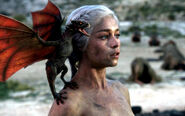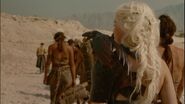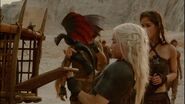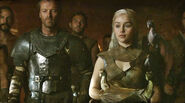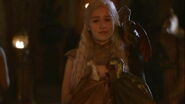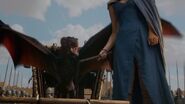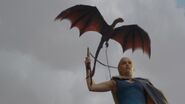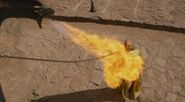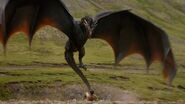- For the unit of currency known as "Gold Dragons", see "Currency".
- "Dragons are fire made flesh. And fire is power."
- ―Quaithe
Daenerys Targaryen and her 'adolescent' dragons
Dragons are massive, flying reptiles which can breathe fire onto their enemies, rumored to have a strong connection to magic. Dragons possess awesome and terrible power, capable of laying waste to armies and burning entire cities to ashes. Men who were able to tame and ride dragons as beasts of war used them to burn their enemies and forge vast empires across the continents of Essos and Westeros.
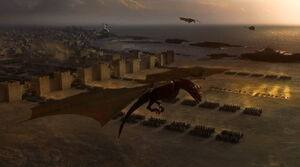
Daenerys marches forward with her army and her young dragons.
The last surviving dragons in the world were possessed by House Targaryen, who used them to conquer and unify the Seven Kingdoms of Westeros three hundred years before the War of the Five Kings. The Targaryen dragons eventually died out about a century and a half later, however, after which the species was considered to be extinct throughout the world.
At the same time that the War of the Five Kings began in Westeros, Daenerys Targaryen - last scion of the deposed House Targaryen - miraculously hatched three new dragons from their eggs, and for the first time in generations, the skies of the world are filled with the music of dragons once again.
Biology
Overview
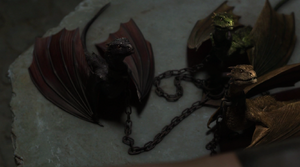
Dragons have different color patterns.
Dragons have long serpentine bodies, with proportionately long necks and tails. Their bodies have four limbs: two short back legs and two large wings as forelimbs, a similar body-plan to a bat. In later generations, after the dragons went extinct, physical descriptions of dragons became so confused in memory that artwork sometimes depicted them as having six limbs - two wings growing out of their backs in addition to four legs - but this is inaccurate. The teeth and claws of adult dragons are as long and sharp as swords.
As reptiles, Dragons are covered in scales, as well as spiny horns which run down their backs from head to tail. Particularly large ridges of horns frame the edges of their faces, running along the back of the skull and along the jawline, which grow bigger as they mature. Adult dragons possess two sets of frills which run along the backs of their necks and spine, two along the sides of their necks and another two centered closer to the backbone, for a total of four frills. These are formed from webbing that grows between longer horny spines. When dragons are agitated (or simply excited), they raise and flare these frills - similar to how a furry animal like a cat will raise the hackles on its back when agitated (or a feathered animal such as a goose will puff up its feathers), in an attempt to appear bigger so as to intimidate its enemies.
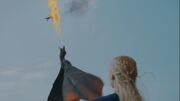
Dragons will sear their food before consumption.
Dragons are obligate carnivores, with diets consisting entirely of meat. Dragons cannot eat uncooked meat, but must sear it with their fire-breath before consuming it. Dragons will instinctively reject raw meat, because they physically cannot digest it. Newborn hatchlings would normally be provided with cooked meat by their parent, but if orphaned they must quickly learn to breath fire so they can roast whatever morsels they find, or else starve. Other than the requirement that it must be cooked, Dragons can eat almost any kind of meat, anything from sheep to fish. Historical dragons ridden as beasts of war were known to eat fallen horses and even men on the battlefield. Fully grown dragons could swallow a live horse whole.
The scale color of dragons is highly variable, and historical dragons ranged in color from black to silver, red, gold, and even blue. Some dragons were one solid color throughout, but more often, they tend to have one primary color for most of their body, with highlights in a secondary color along their spinal crests, horns, and wing membranes. Markings observed so far include:
- Black with red markings
- Green with bronze markings
- Cream with gold markings
Fire-breath
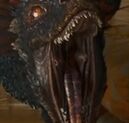
Small tubes in Drogon's mouth showing where they spit fire from.
Probably the most famous attribute of dragons is their ability to breathe fire. Dragonflame can turn flesh to ash, melt steel, and crack stone. Older dragons can produce more intense flame for longer durations. Dragons seem to produce their fire-breath by expelling chemicals out of two tubes in the back of their throats: when these volatile substances combine, they undergo an intense reaction which bursts into a directed jet of fire. The bodies of dragons are also very resistant to fire, particularly their own flames, which don't even damage their own mouths as they expel them. Some believe that in many ways dragons are fire, fire given form as flesh: it is said that "fire cannot kill a dragon".
Reproduction and Maturation
Dragons are born with teeth.
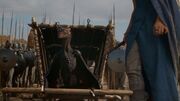
Drogon, already the size of a small dog.
Newborn dragons are about the size of a small cat, and they grow throughout their entire lives. It is not stated at what age they reach maturity or adulthood. Even from a young age, dragons can breath fire at a considerable distance; Daenerys' dragons could all spit fire several meters in their first year of life. For this reason, even baby dragons are extremely dangerous. Dragon fire is said to be much hotter than regular fire, and can easily melt steel and even stone. Dragons breathe fire out off two small tubes can be seen inside a dragon's mouth near their throat. Dragons can fly, and they begin to do so at a very early age, without the need for guidance. All of Daenerys' dragons learned to fly shortly after her departure from Qarth. Dragons can also grow considerably fast, Drogon had grown from the size of a cat to the size of a small dog by the time Daenerys arrived at the city of Astapor in Slaver's Bay after leaving Qarth, her dragons also learned to hunt for themselves, demonstrated when Drogon dove into the water like a modern day brown pelican to catch a fish.
Training and riding
Dragons cannot be tamed but they can be trained or mastered; Aegon the Conqueror commanded three dragons in battle. He and his sister-wives were able to ride the dragons. The extent of mastery depends upon the bond that is formed between the owner and the dragon. Dragons are very over-protective of their owner, all three of Daenery's Dragons became very agitated during a negotiation with a Wise master of Yunkai, in which the latter threatened Daenerys. Dragons can be taught vocal commands as well, even at a young age Daenerys taught her dragons to spit fire when she said "Dracarys" (meaning dragonfire in High Valyrian).
History
Background
Five thousand years ago, men of the Valyrian Freehold learned how to tame and ride dragons as beasts of war, and used them to forge an empire that stretched across most of the continent of Essos, dominating almost half of the Known World. Four hundred years before the War of the Five Kings, the entire Valyrian empire and almost all of its dragons were destroyed in a single day, during a cataclysmic volcanic eruption known as the Doom of Valyria. One Valyrian noble family, the Targaryens, survived the Doom on the distant island outpost of Dragonstone in the Narrow Sea - along with the last surviving Valyrian dragons.
One hundred years later, Aegon I Targaryen and his sisters used the last three surviving dragons in the world to conquer and unify the Seven Kingdoms of Westeros. For generations, the dragon-kings ruled over much of Westeros - but the dragons eventually died out after nearly a century and a half, and the species was subsequently considered to be extinct.
Season 1
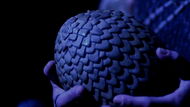
A dragon egg, used as an heirloom or item of value.
In the series the dragon species is established as having been extinct for many years. The only thing left of the race are petrified dragon eggs, which are used as decoration, and the bones which are used for weapon crafting. According to one legend, dragons originated from a second moon that hatched when it drifted too close to the sun. This is mostly dismissed as a simple myth.
They remain the sigil of House Targaryen, who were known to have a special affinity with the creatures. Even a Targaryen like Daenerys who knows nothing of her true heritage feels a connection with the relics of the ancient animals. She appears to feel a connection with the eggs; causing her to develop a curiosity about the race and the possibility that there may still be living dragons.
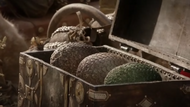
Daenerys' dragon eggs, gifted to her by Illyrio Mopatis.
Daenerys Targaryen is given three petrified dragon eggs as a gift for her wedding to Khal Drogo. The three eggs are black, green and yellow and are initially in poor condition; covered in grime and looking more like stones than egg-like[1].
Daenerys has started caring for the eggs and they have become more rich in color. She also keeps them in a chest surrounded with lit candles, day and night and is drawn to them[2].
Arya stumbles upon the massive skull of one of the Targaryen dragons while chasing a cat in the vaults. She hides in the mouth of the skull and overhears the plotting of Ilyrio and Varys.[3]
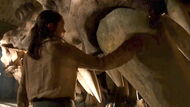
The skull of a dragon, kept in the vaults below the Red Keep of King's Landing.
Daenerys continues to experiment with her eggs. She briefly places one of the eggs into a fire pit in an attempt to hatch it, but the egg remains unhatched. She removes the egg from the fire with her bare hands, but remains unhurt[4].
Daenerys Targaryen places the eggs on the funeral pyre of her husband after smothering him with a pillow. She also straps the witch Mirri Maz Duur to the pyre. She then lights the pyre, and walks into it, with all her followers believing her to be dead. In the morning however, she is found with three dragons, a white-peach colored dragon by her feet, a green one in her arms, and a black dragon clinging on her shoulder that later screeches and flaps its wings[5].
Season 2
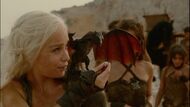
Daenerys tries to feed Drogon raw meat.
Daenerys tries unsuccessfully to feed her dragons raw meat. She is unclear what she is doing wrong.[6] Later, in Qarth, she realizes that they will only eat cooked meat. She coaxes them into recognising the Valyrian command, "Dracarys," to breathe fire, so they can cook their own food.[7]
The dragons are later stolen[8] by the warlocks of Qarth and hidden in the House of the Undying. The warlocks and Xaro Xhoan Daxos carry out a coup to seize control of the city in the wake of the theft. Pyat Pree invites Daenerys to come to the House of the Undying and be reunited with her 'babies'.[9]
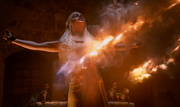
Dany's dragons breathe fire in "Valar Morghulis."
Once Daenerys is inside the citadel she is enthralled by two specific illusions; the Iron Throne room with a destroyed roof and snow falling in and the illusion of her dead husband and child. The sound of the crying dragons pulls Daenerys out of the temptation to stay in either illusion. Continuing her search for her dragons she finds them all chained beside each other, and they scream with excitement when she nears them. Daenerys goes to them, only to find herself chained as well. With her arms stretched to either side of her she becomes a captive. However with a bit of a twisted smile, Daenerys speaks the High Valyrian word for fire, and Drogon first answers her call, but isn't very effective by himself. However then, both Rhaegal and Viserion join in, setting Pyat Pree ablaze.
Known dragons
Daenerys Targaryen's dragons
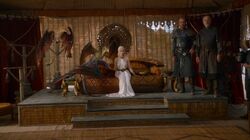
Daenerys and her Dragons.
- Drogon, named after Khal Drogo, black with red markings. Larger than its brothers.
- Rhaegal, named after Rhaegar Targaryen, green with bronze markings.
- Viserion, named after Viserys Targaryen, creamy white, with gold markings.
Known historical dragons
Aegon the Conqueror's dragons
- Balerion, the Black Dread, the largest dragon known, was more than 200 years old when he died. Aegon the Conqueror's steed during the War of Conquest. Allegedly the Iron Throne was forged in his breath. His skull is stored in the Red Keep.
- Meraxes, the dragon of Aegon I's sister-wife Rhaenys. His skull is stored in the Red Keep.
- Vhagar, the dragon of Aegon I's sister-wife Visenya. His skull is stored in the Red Keep.
Other dragons
- Sunfyre, Aegon II Targaryen's personal mount, to whom Aegon fed his half-sister Rhaenyra Targaryen while her son was forced to watch.[10]
- Vermithrax, mentioned by Viserys Targaryen as the name of one of the dragons whose skull is stored in the Red Keep.[11]
- Ghiscar, mentioned by Viserys Targaryen as the name of one of the dragons whose skull is stored in the Red Keep. Apparently named after the Ghiscar region.[12]
- Valryon- mentioned by Viserys Targaryen as the name of one of the dragons whose skull is stored in the Red Keep.[12]
- Essovius- mentioned by Viserys Targaryen as the name of one of the dragons whose skull is stored in the Red Keep.[12]
- Archonei- mentioned by Viserys Targaryen as the name of one of the dragons whose skull is stored in the Red Keep.[12]
- The last dragon- mentioned by Viserys Targaryen as the last known living dragon.[12]
Quotes about dragons
- "Zaldrīzes buzdari iksos daor."
- ―(A dragon is not a slave.)
Daenerys Targaryen to Kraznys mo Nakloz, much to the shock of the latter.
Image Gallery
In the books
In the A Song of Ice and Fire novels, dragons are described as winged, four-limbed creatures (two legs and two foreclaws). This form is more often described as a wyvern in medieval mythology, where dragons are typically four legged.
They are native to the continent of Essos, and were found in significant numbers some five thousand years ago on the Valyrian Peninsula. The people of Valyria tamed the dragons and used them as steeds and weapons of war. Using dragons they forged a vast empire spanning most of the continent until the event known as the Doom destroyed the empire and eliminated most of the dragons. The only dragons known to have survived were the three dragons belonging to House Targaryen, which used them to conquer the Seven Kingdoms.
The Targaryens kept their dragons in Westeros for approximately 130 years. After they died, the Targaryens kept their preserved skulls on display in the Red Keep. Tyrion states that there are nineteen skulls in all, which for a time led to the misconception that there were only ever nineteen Targaryen dragons - however, in the same chapter in which Tyrion describes them, he says that the oldest skull is three thousand years old. The oldest Targaryen dragon was Balerion, who hatched over four hundred years ago and died after living for about two centuries. Thus the nineteen skulls were never an accurate count of all Targaryen dragons, because they apparently acquired several skulls from Essos. According to later information from other short stories, there were at least 24 Targaryen dragons throughout history, though there were possibly a few more. Twenty dragons were alive during the Dance of the Dragons. Several hatchlings also died young in the generations prior to the Dance, and never had dragonriders.
Most of them were killed in the Targaryen civil war known as the Dance of Dragons, which occurred 130 years after the Targaryen Conquest and 150 years before Robert's Rebellion. The short story The Princess and the Queen confirmed that sixteen dragons were alive at the time of the Dance: Rhaenyra's faction based at Dragonstone controlled twelve dragons, while Aegon II's faction at King's Landing controlled only four. However, several of Rhaenyra's dragons were not battle-ready at the time. Interestingly, three of them were actually "wild" dragons. As it turns out, if a dragon is not claimed by a rider when it is young, it becomes extremely difficult to bond with as an adult. Usually there were more Targaryens than there were dragons, but for once, the number of dragons had outpaced the current number of Targaryens. Moreover, dragons only seem to prefer to bond with those like the Targaryens who are descended from Old Valyria. This left Rhaenyra with only nine non-wild dragons, and of these, at least three were very young and hardly battle-ready. Each of Rhaenyra's three sons had a dragon, but the youngest had not yet fully mastered his, and while the dragons of her older two sons could at least fly long distances she was hesitant to send them into harm's way. Making matters worse, Rhaenyra's faction simply didn't have enough Targaryen blood relatives to ride all of the dragons she possessed. Thus a major part of the Dance was Rhaenyra's search for "dragonseeds" - bastard Targaryen children who, as part of the royal bloodline, stood a better chance than most of trying to bond with her remaining dragons. Much effort was also spent in trying to tame the three wild dragons.[13]
Of Aegon's original three dragons, Balerion died in the peaceful reign of King Jaehaerys I almost a hundred years later, while Vhagar was killed in the Dance of Dragons (Meraxes' fate has not been mentioned). The few surviving dragons were weak and sickly, with the last dragon (a stunted creature not much bigger than a large dog) dying during the reign of Aegon III Targaryen, the Dragonbane. The last dragons left behind several eggs, which never hatched. These eggs were later destroyed or lost to the vagaries of history. As a result, dragons are now considered to be extinct.
Aenys I, elder son of Aegon I, bonded with a dragon named Quicksilver, one of the progeny of of Aegon's original three dragons. Aegon I's younger son Maegor the Cruel initially did not bond with any dragon, instead waiting for his father to die so he could bond with and ride Balerion, the largest of all the dragons.[14]
At least six dragons were alive during the rule of King Jaehaerys I, which included Aegon I's original three and three of their progeny. One of these was Silverwing, which belonged to Jaehaerys's sister-wife Queen Alysanne. Quicksilver is mentioned as surviving until the Dance, so it must have also been one of Jaehaerys's six. Later, Rhaenyra Targaryen rode Syrax during the Dance of Dragons, though Syrax may or may not have been one of Jaehaerys I's six.
While there are nineteen dragon skulls in the Red Keep, it isn't clear if this reflects the number of battle-ready dragons the Targaryens ever possessed (even this is assuming that a dragon's skull was recovered every time one died). The Targaryens originally possessed five dragons which they saved from the Doom of Valyria, yet in the century between the Doom and the Targaryen Conquest of Westeros, four of them died, leaving Balerian the Black Dread as the only surviving pre-Doom dragon. However, the other dragons did leave behind eggs, from which Vhagar and Meraxes hatched. It may be reasonable to assume that the skulls of these four dragons were preserved by the Targaryens. Meanwhile, the books state that the last dragons were stunted and sickly creatures who died young; Tyrion notes that the skulls of the last two dragons were no bigger than those of a mastiff (not just the final one emphasized in the TV series). This being the case, there may have been at most thirteen battle-ready Targaryen dragons in history, and probably not all at the same time. With the information from The Princess and the Queen that there were sixteen living dragons when the Dance began, all major dragons may be accounted for: if Balerion did indeed die peacefully before the Dance, and two small sickly dragons were hatched afterwards (and quickly died), these three bring the total number up to nineteen, matching the number of preserved skulls in the Red Keep.
According to Valyrian records, dragons hatch small, about the size of an average cat, but grow larger and larger as their appetites expand. A dragon never stops growing as long as it remains fed. Dragons could live to be over 200 years old, and it is said that Balerion the Black Dread, one of Aegon I's dragons, was so huge by the time he died he could swallow an aurochs whole. Barristan explicitly states that it isn't very clear how long dragons can live before they die of natural causes, because they were bred and used as weapons of war and thus usually died of violent unnatural causes. The few healthy dragons that didn't die in combat still lived at least several centuries.
Dragons could breathe fire and were ferociously strong. However, they were also vulnerable to sustained arrow fire from the ground, to poison and to attacks from other dragons. While extremely powerful, they were not outright invincible, and given their rarity and the large expense in rearing them Aegon was reluctant to commit all of his dragons to a single battle, for fear that they might be overwhelmed through greater numbers and killed. Thus, Aegon took a calculated risk when he fielded all three of his dragons for the first and only time at the climactic Field of Fire, the battle which secured his conquest. The art of taming and commanding dragons enough to ride is almost unknown aside from a few exceedingly rare books.
Dragons, like certain species of lizards, can shift gender and have no fixed sex: they can shift back and forth as the needs of the species require for reproduction. However, they are usually referred to as male.
In the books, Daenerys receives three exceptionally rare dragon eggs as a wedding gift from her longtime host, Illyrio. Despite being told that the eggs are petrified, Daenerys claims to be able to feel heat coming from the eggs. After bringing them with her into the funeral pyre which burns the dead body of her husband Drogo, three baby dragons are hatched (and Daenerys is unharmed): one green, one white, and one black. She names the green one Rhaegal, after her brother Rhaegar, heir to the throne of Westeros after their father Aerys, but killed in Robert's rebellion. The white dragon is named Viserion, after her brother Viserys--her childhood companion and keeper, and rightful heir of the Seven Kingdoms after the death of their brother Rhaegar. The largest dragon, black in color, is named Drogon, in memory of her late husband.
In the books, the bones of dragons are black. In the series, however, the skulls in King's Landing are shown to be white.
Weapons are described as being made of this black dragon bone and the material being very valuable especially for the making of bows as it is stronger and more flexible, making the arrows fly much further. Dragon bone is also fireproof.
In the red waste one of Daenerys Targaryen's scouts returns to report finding the long dead bones of a dragon.
See also
Dragon on A Wiki of Ice and Fire (Major spoilers from the books)
Dragon on Wikipedia
References
- ↑ Winter is Coming
- ↑ The Kingsroad
- ↑ "The Wolf and the Lion"
- ↑ A Golden Crown
- ↑ "Fire and Blood"
- ↑ "The North Remembers"
- ↑ "The Ghost of Harrenhal"
- ↑ "The Old Gods and the New"
- ↑ "A Man Without Honor"
- ↑ "And Now His Watch is Ended"
- ↑ "Cripples, Bastards and Broken Things" - This name does not appear in the books and appears to be an inside joke referring to the dragon in the film Dragonslayer.
- ↑ 12.0 12.1 12.2 12.3 12.4 "Cripples, Bastards and Broken Things"
- ↑ [1]
- ↑ Bubonicon 45 GRRM live-read
Template:Creatures


